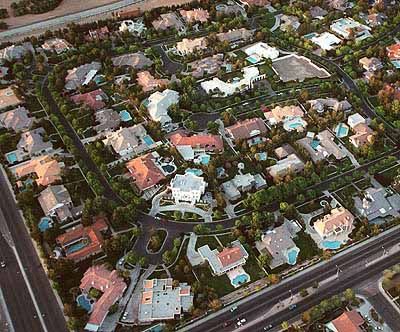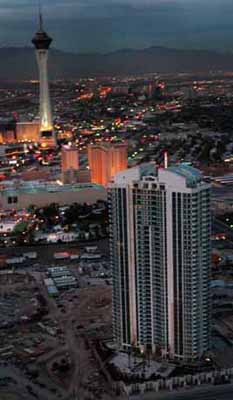 hen I moved to Las Vegas, in March, 2000, I knew essentially nothing about the city outside of the Strip. Now, ten months later, the city is probably more familiar to me than the Strip is. hen I moved to Las Vegas, in March, 2000, I knew essentially nothing about the city outside of the Strip. Now, ten months later, the city is probably more familiar to me than the Strip is.
 inding a place to live is, of course, the most important undertaking. As a beginning, I would suggest 1) obtaining a detailed map of the entire area (AAA has "north" and "south" maps of Las Vegas which are quite good.), and 2) reading the Sunday newspaper, the Las Vegas Sun/Review Journal, for several weeks before making a move. The paper may be available at a local newsstand, or by subscription. By doing this, one can get a good general idea of availability and costs of real estate, either for lease or purchase. inding a place to live is, of course, the most important undertaking. As a beginning, I would suggest 1) obtaining a detailed map of the entire area (AAA has "north" and "south" maps of Las Vegas which are quite good.), and 2) reading the Sunday newspaper, the Las Vegas Sun/Review Journal, for several weeks before making a move. The paper may be available at a local newsstand, or by subscription. By doing this, one can get a good general idea of availability and costs of real estate, either for lease or purchase.
  he community of Summerlin is one of the two most desirable areas of Las Vegas. [Note that the previous link does not display correctly on Webtv. This one will, but the links on the page are inactive.] Located on the western side of the city at the base of the Spring Mountain Range, it is about 7 or 8 years old and still growing. The area is remakably neat and clean. It is a "planned community" with Home Owners' Association fees and CC&R's. Apartments, condos, and individual homes are available. he community of Summerlin is one of the two most desirable areas of Las Vegas. [Note that the previous link does not display correctly on Webtv. This one will, but the links on the page are inactive.] Located on the western side of the city at the base of the Spring Mountain Range, it is about 7 or 8 years old and still growing. The area is remakably neat and clean. It is a "planned community" with Home Owners' Association fees and CC&R's. Apartments, condos, and individual homes are available.
  he other "planned community" is Green Valley, located in southeast Las Vegas - northwest Henderson. (I can't find any website for this community.) It is similar in most respects to Summerlin, although I get the impression that there may be more families with young children in Green Valley. But I could well be wrong!. he other "planned community" is Green Valley, located in southeast Las Vegas - northwest Henderson. (I can't find any website for this community.) It is similar in most respects to Summerlin, although I get the impression that there may be more families with young children in Green Valley. But I could well be wrong!.
 he northeast section of Las Vegas is an industrial area and home to Nellis AFB Many mobile home parks are located in this sector. he northeast section of Las Vegas is an industrial area and home to Nellis AFB Many mobile home parks are located in this sector.
 enerally speaking, from these peripheral, suburban areas, the value and quality of real estate decrease as one moves towards downtown and the Strip. enerally speaking, from these peripheral, suburban areas, the value and quality of real estate decrease as one moves towards downtown and the Strip.
  here is, however, a luxury, high rise condominium complex, Turnberry Place, just a couple blocks off the Strip. Price range: $450,000 to $4,000,000. here is, however, a luxury, high rise condominium complex, Turnberry Place, just a couple blocks off the Strip. Price range: $450,000 to $4,000,000.
 s mentioned earlier in these pages, rental property is averaging about 79¢/sq.ft. For purchase, the going rate seems to be about $82/sq.ft. This really isn't too bad! s mentioned earlier in these pages, rental property is averaging about 79¢/sq.ft. For purchase, the going rate seems to be about $82/sq.ft. This really isn't too bad!
 sually, after living accomodations, the next significant budgetary item is food. The "Shopping" page (on the sidebar) describes the markets in the area. The cost of food items seems to be about the same as in San Diego, for instance. Fresh fruit may be just a bit higher, but dairy products seem to be a bit less. Large eggs, for example, are about 78¢/dozen; milk is about $2/half gallon. However, with judicious selection, and the use of store discount cards, one can frequently obtain milk for $1 to $1.45/half gallon. Iceberg lettuce is currently (winter-time) about $1.25/head; lemons are 39¢ to 59¢ each. Milk-fed veal (scallopini) is about $16/pound; ground beef sirloin is about $2.89/pound. sually, after living accomodations, the next significant budgetary item is food. The "Shopping" page (on the sidebar) describes the markets in the area. The cost of food items seems to be about the same as in San Diego, for instance. Fresh fruit may be just a bit higher, but dairy products seem to be a bit less. Large eggs, for example, are about 78¢/dozen; milk is about $2/half gallon. However, with judicious selection, and the use of store discount cards, one can frequently obtain milk for $1 to $1.45/half gallon. Iceberg lettuce is currently (winter-time) about $1.25/head; lemons are 39¢ to 59¢ each. Milk-fed veal (scallopini) is about $16/pound; ground beef sirloin is about $2.89/pound.
 utomobile expenses are fairly standard for the western United States. Premium, name brand gasoline varies from about $1.73 to $2.00/gallon. This varies throughout the city and from one station to another, and from week to week. A lubrication and oil/filter change, at a car dealership, is about $19 or $20. Auto insurance is expensive, as is auto registration. There is no "good driver discount" in Nevada, and the collision portion of the insurance is high. Smog certification (about $15) is required annually. utomobile expenses are fairly standard for the western United States. Premium, name brand gasoline varies from about $1.73 to $2.00/gallon. This varies throughout the city and from one station to another, and from week to week. A lubrication and oil/filter change, at a car dealership, is about $19 or $20. Auto insurance is expensive, as is auto registration. There is no "good driver discount" in Nevada, and the collision portion of the insurance is high. Smog certification (about $15) is required annually.
 omeowner's Insurance seems to be within the standard price range. Earthquake and flood insurance is generally not needed. omeowner's Insurance seems to be within the standard price range. Earthquake and flood insurance is generally not needed.
 eal estate taxes are just under 1% of the value of the property. The calculation is a bit complicated and is described here. Some areas of the city have SID assessments which may amount to about $180/year, usually ending in 10 or 12 years. eal estate taxes are just under 1% of the value of the property. The calculation is a bit complicated and is described here. Some areas of the city have SID assessments which may amount to about $180/year, usually ending in 10 or 12 years.
 he annual sewer bill is $140. Electricity is approximately 7¢/kwh; gas is approximately 70¢/therm. A monthly service charge of $5 to $6 applies. he annual sewer bill is $140. Electricity is approximately 7¢/kwh; gas is approximately 70¢/therm. A monthly service charge of $5 to $6 applies.
 here is no state income tax, and the local sales tax rate is 7.25%. here is no state income tax, and the local sales tax rate is 7.25%.
|